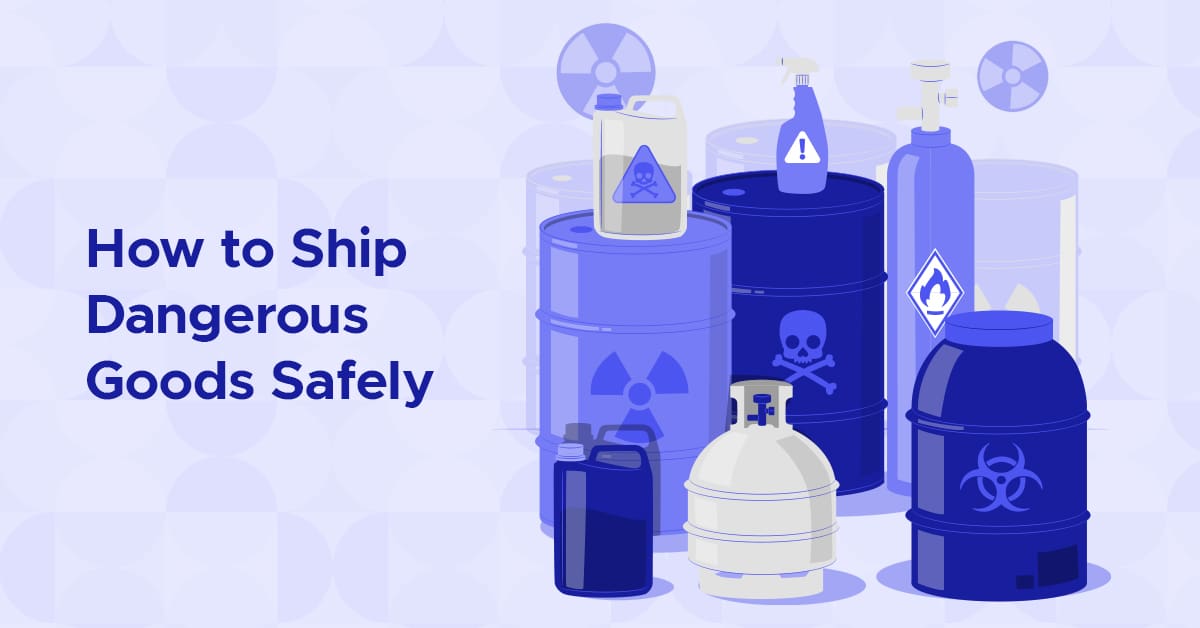
How to Ship Dangerous Goods Safely

This is a guest post from ShipSaving. ShipSaving provides streamlined shipping solutions for eCommerce businesses and seamlessly integrates with major marketplaces. The platform simplifies the shipping process through real-time inventory management and automated label printing.
The complexities of shipping can be challenging, especially when dealing with a range of item types. This how to ship dangerous goods safely guide offers insights into the nuances of shipping general, dangerous, and prohibited items to ensure compliance and safety in your fulfillment practices.
1. General items
In shipping, general items make up a broad category. These everyday objects include a wide array of items such as clothing, books, and household goods and are typically shipped without special handling or concern for additional risks. Their uncomplicated nature makes them the backbone of most shipping processes, as they’re free from inherent hazards or unique requirements.
However, despite their simplicity, it’s still important to have adequate packaging for these items to preserve their condition during transit. To achieve this, you need to employ effective packaging strategies like choosing the right size boxes and securely sealing the contents.

Other packing tips for general items include:
- Sturdy packaging: Use robust packaging materials to protect items from damage during transit.
- Proper labeling: Clearly label each package with the destination address and any handling instructions.
- Cushioning: Insert bubble wrap or packing peanuts to prevent items from moving inside the box.
2. How to ship dangerous goods
On the opposite end of the spectrum are dangerous items (HAZMAT), a category that necessitates special attention due to the inherent risks they pose. These items include but are not limited to batteries, chemicals, flammable materials, and a surprising variety of everyday products like perfumes and certain cosmetics.
Classification of dangerous goods
Dangerous goods are categorized into nine classes based on their nature and risk factors. These groups cover a wide range of products, from explosives and radioactive materials to common items like hairspray and nail polish, each of which pose distinct shipping risks.

Source: Federal Motor Carrier Safety Administration
Choosing the right carrier
The challenge with dangerous items is the diverse regulations and handling procedures that differ across carriers and geographical regions. Given the various risks associated with this category, many carriers have crafted their own shipping guidelines, including:
These rules help ensure compliance with regulations and the safe handling of hazardous materials like aerosols, certain electronics, and medicine. What sellers need to understand when it comes to how to ship dangerous goods is that they need to abide by relevant requirements in advance. They also may have to provide more detailed item information or utilize special packaging.
Sometimes, shipping these items may require additional fees as well. By using ShipSaving, you can obtain professional advice, ensuring your shipping process for dangerous goods complies with regulations. For instance, purchasing domestic U.S. shipping labels through the ShipSaving platform only supports using USPS Ground Advantage™ service for shipping dangerous items (HAZMAT).
Guidelines for how to ship dangerous goods
Regulatory compliance
Before shipping dangerous goods, it’s essential to familiarize yourself with the regulations of various authorities, like the International Air Transport Association (IATA) for air transport and the Department of Transportation (DOT) for ground shipping in the U.S. Compliance with these rules ensures safety and avoids legal repercussions.
Packing guidelines for dangerous goods
- Proper labeling: Clearly label the package with the appropriate hazard class and handling instructions to protect handlers and emergency responders.
- Secure packing materials: Utilize materials capable of withstanding shocks, vibrations, and pressure changes. Employ cushioning and absorbent materials to prevent movement and leaks within the package.
- Sealing and waterproofing: Ensure all containers are tightly sealed and waterproofed to guard against spillage and exposure to external elements.
- Content compatibility: Especially important for chemical substances, pack items together to ensure they’re safe and non-reactive.
- Temperature control: Include insulating materials or devices to maintain a stable environment for temperature-sensitive goods.

3. Prohibited items
Prohibited items represent a critical category in shipping, encompassing goods that are forbidden to be mailed or transported under any circumstances. These include flammable and explosive items, drugs, weapons, live animals and plants, subversive propaganda, etc.
The consequences of attempting to ship prohibited items are severe, ranging from their confiscation to potential legal liability. These requirements are in place to safeguard all parties involved in the shipping process, so it’s imperative to have a thorough understanding of and strictly adhere to them.
The following links contain restrictions on prohibited items for the four major U.S. carriers:
Wrapping up how to ship dangerous goods — Take care with every shipment
Understanding the specific shipping requirements for each item category is crucial for both uninterrupted logistics and legal compliance. Various carriers and governmental bodies have specific guidelines, so invest time in learning their unique rules. Always abide by relevant regulations and take necessary precautions for safe, smooth shipments every time.

